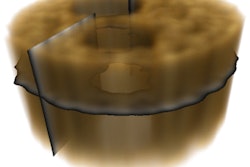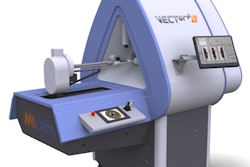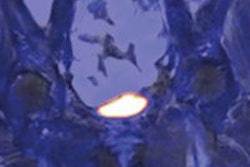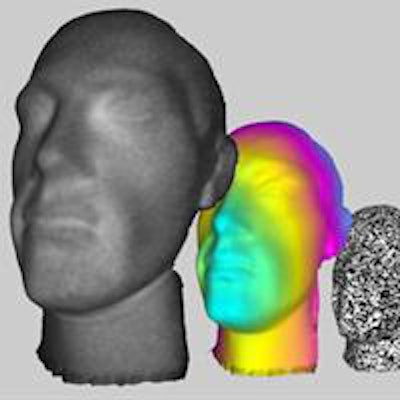
A 3D imaging system that does not require a conventional camera has been developed by researchers in the U.K. The computational technique uses information from single-pixel detectors to create an image, can be used over a range of wavelengths, and is cheaper than other 3D methods. The researchers claim that, in addition to taking images, their system could be used as a detector in oil and gas exploration as well as in medical and biological imaging systems.
Most imaging systems -- from cameras to the retinas in our eyes -- capture images in 2D and then process the information to create a 3D image. While plenty of 3D imaging techniques exist -- including stereoscopic, holographic, and volumetric imaging -- they are expensive and require bulky and specialized equipment, such as lenses and lasers. And despite all this advanced technology, the techniques only work for light at specific wavelengths.
 The image shows different versions of the head reconstructed by Sun et al. From the left, the first head is a 3D view of the grayscale image from the detectors. The second is the final reconstructed 3D head from a side view, while the third head shows the binary speckle patterns used by the group. All images courtesy of Sun et al, University of Glasgow/Science.
The image shows different versions of the head reconstructed by Sun et al. From the left, the first head is a 3D view of the grayscale image from the detectors. The second is the final reconstructed 3D head from a side view, while the third head shows the binary speckle patterns used by the group. All images courtesy of Sun et al, University of Glasgow/Science.Illuminated imaging
Baoqing Sun, Miles Padgett, and others from the University of Glasgow, along with other U.K.-based colleagues at Cambridge University, set out to create a simple system that can deliver 3D imaging without a camera or any other lenses. Sun told physicsworld.com that the team's new technique involves using nothing more than a light projector, four single-pixel detectors and a computational imaging technique known as "ghost imaging" (Science, 17 May 2013).
Computational ghost imaging creates images using "intelligent illumination." The object to be imaged is lit with a specific, known light pattern (such as a speckle pattern) and the reflected light is detected by a single-pixel photodetector. This device has no spatial resolution and merely collects all the light that is incident on it. The multiple signals of the varying light intensity from the detector are then processed, along with the knowledge of the lighting pattern, to build up the final image. Until now, however, this technique has only been used to build 2D images.
Checkered patterns
In this latest work, the team used a simple light projector to illuminate a polystyrene model of a human head with computer-generated random binary speckle patterns. The light reflected from the head was collected by four single-pixel detectors, which are placed at different angles. Thanks to the random binary speckle patterns -- which illuminate the object with a "checkered" pattern -- and the varying angles of the detectors, the team was able to see a clear shading profile in the images.
"For each detector, we saw a 2D image that appeared to be illuminated from a different direction, even though we used only one projector to illuminate the head," Sun said. The individual images were reconstructed using an iterative algorithm that the team created. From the shading of the images, the researchers measured the surface reflectivity and the varying depth of surface features could be derived. The 3D head was reconstructed by integrating more than 1 million iterations of the images. Sun also explains that different speckle patterns are projected one after another and that the greater the number of patterns used, the sharper and more highly resolved the final image.
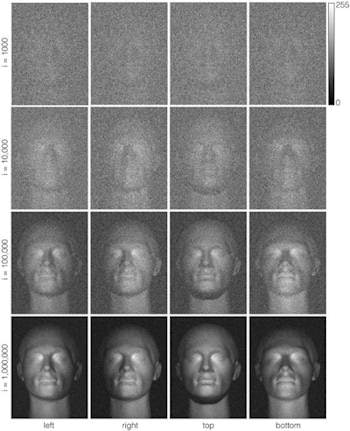 Source images from the four single-pixel detectors from 1,000 to 1 million iterations. The images from each photodetector are reconstructed using an iterative algorithm. The spatial information in each image is identical, however, the apparent illumination source is determined by the location of the relevant photodetector, indicated underneath. No postprocessing has been applied to the images. The scale refers to the relative intensity of the images.
Source images from the four single-pixel detectors from 1,000 to 1 million iterations. The images from each photodetector are reconstructed using an iterative algorithm. The spatial information in each image is identical, however, the apparent illumination source is determined by the location of the relevant photodetector, indicated underneath. No postprocessing has been applied to the images. The scale refers to the relative intensity of the images.Across the range
In terms of adapting the new technology to real-world applications, Sun points out that all of the experiments to date have been carried out in a lab.
"So if this was to be used outside in bright sunlight, or any such environment, we will have to account for the high noise levels, and this is something we are working on," he said.
But at the same time, he explains that the system works well as a cheap "3D camera" and can be used across a wider wavelength range -- from ultraviolet to infrared -- compared with normal cameras. This could allow it to be used as a detector in oil and gas exploration, where infrared remote-sensing technologies are used to "see" oil reserves.
The team is also keen to collaborate with other researchers to extend the 3D computational ghost imaging to the terahertz scale, so that it could be used to carry out medical as well as other biological imaging, and this is something the researchers are currently in the process of doing.
© IOP Publishing Limited. Republished with permission from medicalphysicsweb, a community website covering fundamental research and emerging technologies in medical imaging and radiation therapy.





